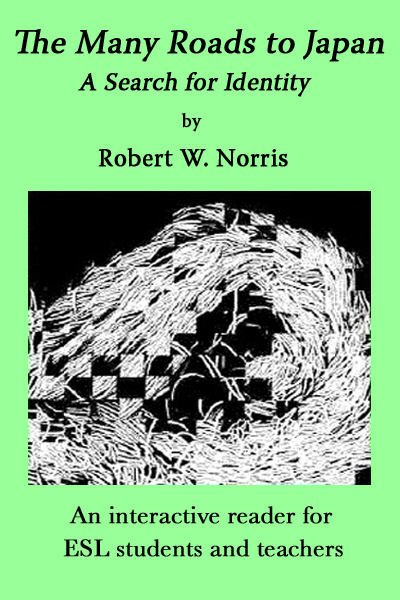
Home About Robert CV The Good Lord Willing and the Creek Don't Rise: Pentimento Memories of Mom and Me Novels Reviews ESL Papers (can be viewed online by clicking on titles) The Many Roads to Japan (free online version for ESL/EFL teachers and students) Contact     |
Robert W. Norris 1992. In Cross Currents Vol. 19, No. 2: 192-195 Introduction Teachers of large "eisakubun" (writing) classes at Japanese universities and colleges face a difficult task in determining how much and what kind of written feedback to use on student papers. This Bright Idea presents a simple and effective correction system built around three main concepts: (1) recognition and elimination of common errors, (2) humor and Stevick's (1976, 1982) concept of "cognitive depth" (i.e., the processing of language stimulus to a deep level of memory, where the possibility of long-term or permanent retention is increased), and (3) an error-marking system that is easy for students to use in correcting their own errors. Thus far, the system has been enthusiastically received and the results have been encouraging. Common Errors
Having taught in Japan for ten years and having compiled many lists of common errors made by Japanese students of English, I have noticed a definite consistency among error types. Although a complete list of common errors would be too large to be addressed in a class that meets no more than 28 times a year, attention can be given to the most obvious errors. The most common errors (and examples) which I have chosen to actively correct in my "eisakubun" classes are listed below: Mistakes in collective
nouns and the noun "people."
a. My families are four.
b. Almost all peoples in Japan eat rice. Wrong pattern for the past
tense. This includes use of the "be" verb form and the
"become + verb" form.
a. It was taste very
good.
b. I became want to study English. Wrong usage of the passive
and active voices.
a. I was enjoy this
book.
b. Our bedroom used for many kind of room. Omission of verbs after
the auxiliary "can."
a. My friend can English
very well.
b. He could everything at school. Insertion of unnecessary
verbs, particularly the "be" verb.
a. I am really believe
music is good for humans.
b. People are keep quiet. Wrong usage or omission of
prepositions.
a. At January it snowed
very much.
b. We stayed Tokyo two years. Wrong usage of articles.
a. I bought a present
for a my friend.
b. Apples is not the vegetable. Lack of subject-verb
agreement.
a. Every man are hard
worker.
b. She play with my sister. Starting too many
sentences with conjunctions.
a. I like music. And I
like dancing. And I like chocolate.
b. I brought my umbrella. Because it was raining. So I am not wet. Wrong usage of present
tense or future tense in a clause denoting the action
(or the state) of the past.
a. I go back home last
summer.
b. Everybody thought he will become angry. Wrong choice of words.
a. About uniforms there
are decided school and freedom school.
b. I tripped to America. Wrong usage of the present
and past participle in such verbs as "interest,"
"excite," "surprise," and so on.
a. I am interesting in
American music.
b. It was a very excited news. Error Lists, Humor,
and "Depth"
Error lists form the central component of the four-week cycle. Their use is designed to meet cultural expectations1, facilitate students' grammar consciousness-raising, and make use of Stevick's concept of "depth" in language acquisition. The system for using the error lists is simple. Concentrating on the types of common errors outlined earlier, the teacher takes about twenty examples of these errors from student letters and compositions, makes a list, and hands out copies of the list in the fourth week of the cycle. To retain the anonymity of the writers and avoid singling anyone out, changes in verbs and nouns are often made. During the first half of the class the students work in small groups discussing and correcting errors. During the second half of the class the teacher gives a lecture on the errors. The lecture is filled with as much humor as possible. This humor is an exaggeration of what a native speaker's reaction might be to some of the errors on the list. Below are some typical errors taken from student papers, and examples of the author's presentation: 1. "My family is four": The teacher demonstrates an imaginary exchange: "That's interesting. What an unusual family you have. Let's see. Your father is four years old. Your mother is four years old. Your brother is four years old. Everyone is four years old! By the way, how did you get to be 18 years old?" The teacher rewrites the sentence in correct form. 2. "I tripped to Tokyo": The teacher explains "trip" is normally used as a noun ("I took a trip"), then demonstrates slapstick style "trip" as a verb. The teacher designates a place across the room as "Tokyo" and "trips to Tokyo." 3. "Son is elementary school": The teacher draws a family on the board: a women, two little girls, and a building. The teacher writes a name by each figure, then acts out an exchange with an imaginary stranger: "Hello, Mr. Smith. I'd like you to meet my family. This is my wife Sally (pointing to the woman figure). These are my two daughters, Betty and Sue (pointing to the girl figures). And this is my son John (pointing to the building figure). He is an elementary school!" The teacher gives examples of correct usage. 4. "He was died his wife": The teacher writes on the board these sentences: a. He was killed by his
wife.
b. His wife was killed by him. c. He killed his wife. d. His wife killed him. e. He was dead, but now he is alive. f. His wife was dead, but now she is alive. g. He died. h. His wife died. 5. "The book was excited." The teacher acts out a conversation with the book, who says, "Oh my God! The Yakult Swallows won the pennant! I'm so happy! I'm so excited!" (the teacher shows the book jumping up and down) and the teacher, who says, "Now calm down. Don't get so excited. You might have a heart attack." The teacher explains the "-ing" participle is normally used to describe things and people's characters, while the "-ed" participle is normally used to describe feelings. The teacher puts correct examples on the board (e.g., "The fans were excited" "The game was exciting"). There is a method to this madness. First of all, humor is an often underused and unexploited variable in creating a positive classroom atmosphere. Secondly, the type of humor used in the error correction lecture is designed to create strong, often exaggerated, images that have the potential to touch the students on affective or emotional levels. In short, the humor used in the lecture is a vehicle to take the material being learned into deeper levels of cognitive awareness, that is, into long-term or even permanent memory. Not every error on the list needs to be presented comically, but humor is an effective teaching tool where applicable. Most errors do lend themselves to a variety of possible interpretations. Any teacher should be able to come up with a few humorous explanations within a single list of errors. When using humor, there is one point the teacher should keep in mind. It is essential that these interpretations not turn into any kind of condescending or derogatory comment. Errors should always be seen as learning tools. The message to the students should be that errors are a natural part of learning and everyone makes them. If a relaxed atmosphere has been created and the teacher is seen as enjoying his/her experience with the students, it is unlikely that any negative and unwanted impressions will be derived from the use of humor in correcting errors. Error-Marking System
From the start of the second four-week cycle the teacher can begin introducing the numbered error-marking system. Errors on the error lists are put in numerical order. For example, the first list might be numbered 1-20, the second 21-40, and so on. The errors on the lists should be the repetitive and common types discussed previously. Thus, it becomes easy for the teacher, when marking student papers, to circle the most troublesome errors and write their corresponding numbers, which are on the error lists the students have. The students are then able to review their notes, make corrections, and hand in the revised papers at a later date. In addition to putting the responsibility for correction on the students, another advantage of the numbered error-marking system is that the students' memories of the slapstick humor used in the error-correction lecture will be triggered. In referring the student back to that experience the image is reinforced and driven to a "deeper" level where the possibility of retention is stronger. If the student felt a bond with the teacher at the moment of the error being explained, and if s/he had an emotional reaction (laughing), the information received at that moment has a good chance of moving closer toward long-term memory. Conclusion
With the usual "eisakubun" classes in Japan numbering over 40 students, correction of individual papers imposes an intolerable burden on even the most dedicated teachers. By concentrating on certain common types of errors and using a numbered correction system, however, teachers can greatly improve the efficiency and effectiveness of their classes; correction time is reduced, students are made to think through their errors (as opposed to cursorily glancing at the teacher's written comments and suggestions), and compositions are used for teaching rather than for unsystematic practice or constant testing. If the teacher can feel comfortable in the role of occasional entertainer or "ham," the humor-filled correction lecture can go a long way toward creating a classroom atmosphere where "affective filters are lowered" (Krashen 1981, 1982)2, as well as promoting "depth" in the retention of the patterns and structures to which the students are exposed. NOTES
1. For detailed comments and analyses of cultural expectations and grammar teaching within the Japanese education system, see Beers and Rittmaster; Brown and Helgesen; Dissosway; and Murray, The Language Teacher, June 1989. 2. Krashen's Theory of Second Language Acquisition incorporates the notion of the Affective Filter as proposed by Dulay and Burt (1977). The filter controls how much language input the learner is open to and how "deep" the input reaches. Learners with high motivation and self-confidence and with low anxiety have "low filters." REFERENCES
Dulay, H., & Burt, M. (1977). Remarks on creativity in language acquisition. In M. Burt, H. Dulay, & M. Finocchiaro (Eds.), Viewpoints on English as a second language. New York: Regents. Krashen, S. (1981). Second language acquisition and second language learning. Oxford: Pergamon. Krashen, S. (1982). Principles and practice in second language acquisition. Oxford: Pergamon. Stevick, E. (1976). Memory, meaning, and method: Some psychological perspectives on language learning. Rowley, MA: Newbury House. Stevick, E. (1982). Teaching and learning languages. Cambridge: Cambridge University Press. Copyright (c) 1992, 1998-2021 Robert W. Norris. All Rights Reserved |